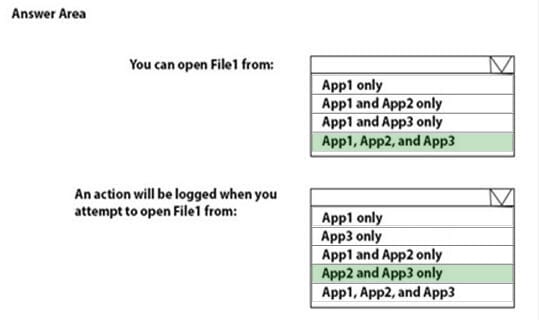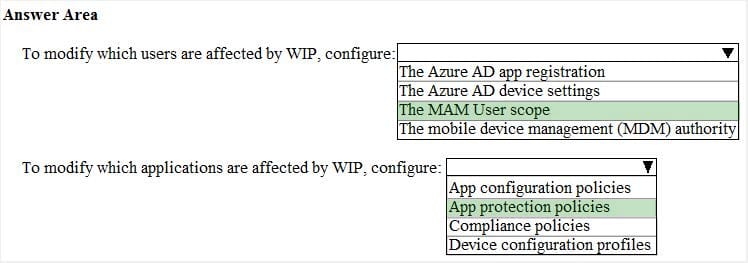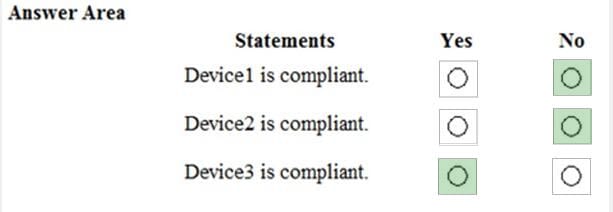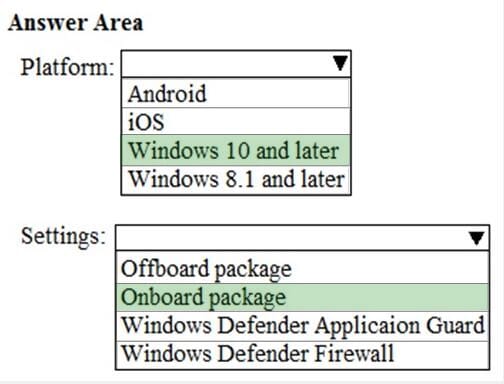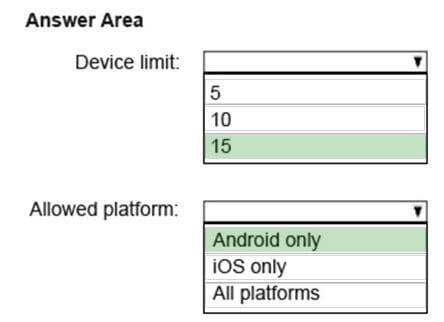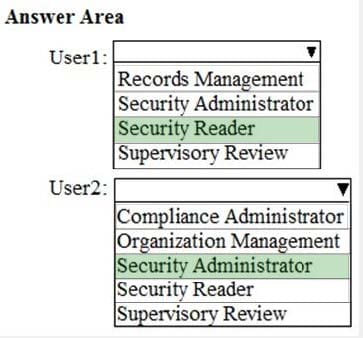Exam Details
Exam Code
:MS-100Exam Name
:Microsoft 365 Identity and ServicesCertification
:Microsoft CertificationsVendor
:MicrosoftTotal Questions
:535 Q&AsLast Updated
:Apr 10, 2025
Microsoft Microsoft Certifications MS-100 Questions & Answers
-
Question 171:
HOTSPOT
You have a Microsoft Azure Active Directory (Azure AD) tenant named contoso.com.
You have three applications App1, App2, App3. The Apps use files that have the same file extensions.
Your company uses Windows Information Protection (WIP). WIP has the following configurations:
1.
Windows Information Protection mode: Silent
2.
Protected apps: App1
3.
Exempt apps: App2
From App1, you create a file named File1.
What is the effect of the configurations? To answer, select the appropriate options in the answer area.
Hot Area:
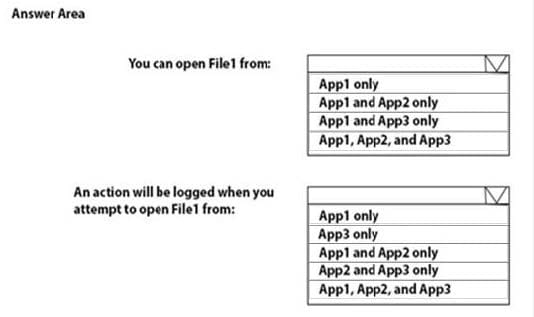
-
Question 172:
HOTSPOT
You have a Microsoft Azure Active Directory (Azure AD) tenant.
Your company implements Windows Information Protection (WIP).
You need to modify which users and applications are affected by WIP.
What should you do? To answer, select the appropriate options in the answer area.
NOTE: Each correct selection is worth one point.
Hot Area:
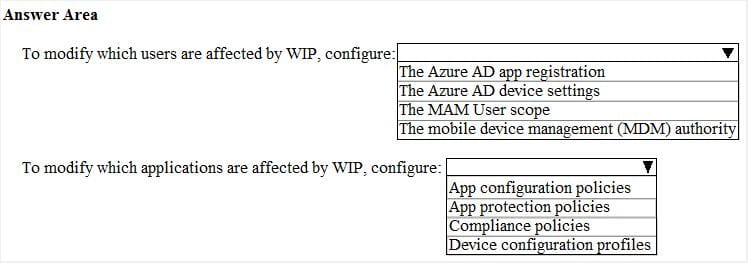
-
Question 173:
HOTSPOT
You have three devices enrolled in Microsoft Intune as shown in the following table.

The device compliance policies in Intune are configured as shown in the following table.

The device compliance policies have the assignment shown in the following table.

For each of the following statements, select Yes if the statement is true. Otherwise, select No. NOTE: Each correct selection is worth one point.
Hot Area:
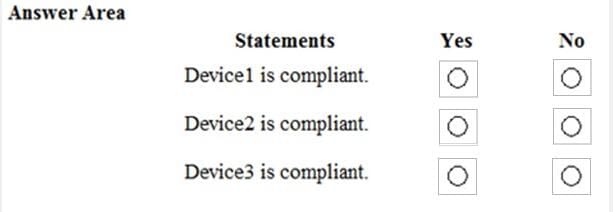
-
Question 174:
HOTSPOT
You have a Microsoft 365 subscription.
You need to implement Windows Defender Advanced Threat Protection (ATP) for all the supported devices enrolled devices enrolled on mobile device management (MDM).
What should you include in the device configuration profile? To answer, select the appropriate options in the answer area.
NOTE: Each correct selection is worth one point.
Hot Area:
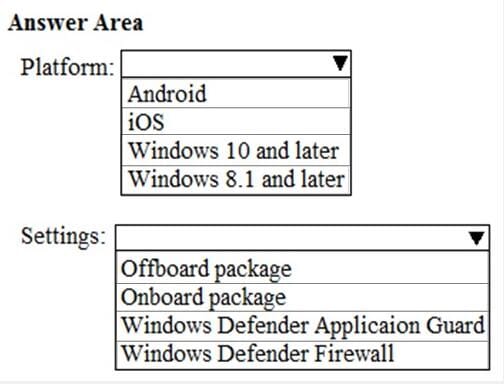
-
Question 175:
HOTSPOT
You have a new Microsoft 365 subscription.
A user named User1 has a mailbox in Microsoft Exchange Online.
You need to log any changes to the mailbox folder permissions of User1.
Which command should you run? To answer, select the appropriate options in the answer area.
NOTE: Each correct selection is worth one point.
Hot Area:

-
Question 176:
HOTSPOT
Your company has a Microsoft 365 tenant.
You plan to allow users from the engineering department to enroll their mobile device in mobile device management (MDM).
The device type restrictions are configured as shown in the following table.

The device limit restrictions are configured as shown in the following table.

What is the effective configuration for the members of the Engineering group? To answer, select the appropriate options in the answer area. NOTE: Each correct selection is worth one point.
Hot Area:

-
Question 177:
HOTSPOT
You have a Microsoft 365 subscription.
You are configuring permissions for Security and Compliance.
You need to ensure that the users can perform the tasks shown in the following table.

The solution must use the principle of least privilege.
To which role should you assign each user? To answer, select the appropriate options in the answer area.
NOTE: Each correct selection is worth one point.
Hot Area:

-
Question 178:
HOTSPOT
You have several devices enrolled in Microsoft Intune.
You have a Microsoft Azure Active Directory (Azure AD) tenant that includes the users shown in the following table.

The device type restrictions in Intune are configured as shown in the following table.

You add User3 as a device enrollment manager in Intune.
For each of the following statements, select Yes if the statement is true. Otherwise, select No.
NOTE: Each correct selection is worth one point.
Hot Area:

-
Question 179:
HOTSPOT
You have a Microsoft Azure Active Directory (Azure AD) tenant that contains the users shown in the following table.

Your company uses Windows Defender Advanced Threat Protection (ATP). Windows Defender ATP contains the roles shown in the following table.

Windows Defender ATP contains the device groups shown in the following table.

For each of the following statements, select Yes if the statement is true. Otherwise, select No. NOTE: Each correct selection is worth one point.
Hot Area:

-
Question 180:
HOTSPOT
You have the Microsoft Azure Active Directory (Azure AD) users shown in the following table.

Your company uses Microsoft Intune.
Several devices are enrolled in Intune as shown in the following table.

The device compliance policies in Intune are configured as shown in the following table.

You create a conditional access policy that has the following settings: The Assignments settings are configured as follows:
-Users and groups: Group1
-Cloud apps: Exchange Online
-Conditions: Include All device state, exclude Device marked as compliant Access controls is set to Block access.
For each of the following statements, select yes if the statement is true. Otherwise, select No.
NOTE: Each correct selection is worth one point.
Hot Area:

Related Exams:
62-193
Technology Literacy for Educators70-243
Administering and Deploying System Center 2012 Configuration Manager70-355
Universal Windows Platform – App Data, Services, and Coding Patterns77-420
Excel 201377-427
Excel 2013 Expert Part One77-725
Word 2016 Core Document Creation, Collaboration and Communication77-726
Word 2016 Expert Creating Documents for Effective Communication77-727
Excel 2016 Core Data Analysis, Manipulation, and Presentation77-728
Excel 2016 Expert: Interpreting Data for Insights77-731
Outlook 2016 Core Communication, Collaboration and Email Skills
Tips on How to Prepare for the Exams
Nowadays, the certification exams become more and more important and required by more and more enterprises when applying for a job. But how to prepare for the exam effectively? How to prepare for the exam in a short time with less efforts? How to get a ideal result and how to find the most reliable resources? Here on Vcedump.com, you will find all the answers. Vcedump.com provide not only Microsoft exam questions, answers and explanations but also complete assistance on your exam preparation and certification application. If you are confused on your MS-100 exam preparations and Microsoft certification application, do not hesitate to visit our Vcedump.com to find your solutions here.
